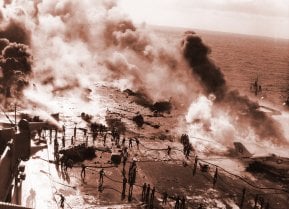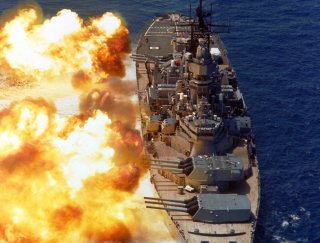Warship Mystery: How Did This Battleship's 16-Inch Gun Explode?
Navy leaders hoped they would not have to answer questions about the underlying causes of the disaster.
Those changes included inspecting the Navy's entire inventory of powder bags, discarding any bags packed in a certain way that could lead to an accidental explosion, and making sure the rammer control level on 16-inch guns could not be moved to the high speed position while loading powder bags, according to a 1991 Navy-wide message.
More than two years after the deadly explosion, then-Chief of Naval Operations Adm. Frank Kelso reluctantly apologized to Hartwig's family in October 1991. He offered no apology to Truitt or Smith.
"We did not accuse Kendall Truitt of anything in the investigation or the other gent," Kelso said. "I regret the accident occurred, obviously. I'm very sorry it ever occurred. I think it was a terrible, terrific tragedy that we had. I'm sorry for anyone's personal grief or personal anguish over that."
"I extend my sincere regrets to the family of Hartwig," he said. "We're sorry Clayton Hartwig was accused of this."
'It smacked of a cover-up'
For Carroll, the former Naval Safety Center spokesman, the Iowa explosion and the Navy's first attempt to explain it sounded eerily similar to the USS McCain and Fitzgerald collisions in 2017.
"This dynamic is kind of classic with respect to a catastrophe and the [cover your ass mentality] that follows it," said Carroll.
Navy leaders hoped that the media would accept the theory that Hartwig was responsible for the blast so they would not have to answer questions about the underlying causes of the disaster, said Carroll, now director of outreach and marketing for the U.S. Naval Institute.
"What became obvious in time was this was another classic circumstance of mishandling the initial information and creating these causal factors that proved to be inaccurate – and a bit sensational, really, with respect to the homosexual love triangle," Carroll told Task & Purpose.
"When it's all said and done, it smacked of a cover-up. Certainly, the families of the fallen sailors were not satisfied with the initial report – and in some ways, those questions have never been fully answered."
The explosion meant the end of the line for the Iowa. The ship was decommissioned in October 1990.
The other three Iowa-class battleships that had been reactivated were also decommissioned over the next couple years because they were too expensive to operate, their manning needs could not be met, and sailors had to train to operate equipment on them that was not found on other warships, said Ryan Peeks, a naval historian with Naval History and Heritage Command.
"While negative publicity from the Iowa turret explosion did not help the case for keeping the battleships in service, the decision to decommission them was simply a case of Navy leadership finding that other classes of warship provided more capability (especially with regard to carrying cruise missiles) for less money," Peeks told Task & Purpose.
Coping in the aftermath
Truitt is currently unemployed. It's been hard for him to hold down a job since the explosion 30 years ago.
He left the Navy, attended college, and worked for different contractors that his uncle hired when he developed properties. Eventually, the media attention surrounding him faded away.
But the experience of defending Hartwig from false accusations has left a lasting impression on Truitt that has made it difficult to avoid conflicts.
"I've found that I have a heightened sense of right and wrong and I don't suffer fools very well," he said. "I have lost a few jobs based on principles when a normal person might have been able to shrug it off. I don't play politics very well. I'm incredibly direct. It serves me well with managers that appreciate that. It has not served me well in the larger corporations."
Truitt had been married for four months at the time of the explosion. He and his wife divorced in 1991.
"My wife was supportive for a couple of years, and then had had enough of the press conferences, enough of the drama," he said.
"My wife's family was very supportive, but unfortunately, it cost them their business. (They had recently opened a small restaurant in a strip mall that had been growing, "but once they openly supported me in the press, their business quickly failed due to loss of customers," he said.)
A few of Truitt's family members could not understand why it was so important for him to clear Hartwig's name. They just wanted all the notoriety to go away, and eventually, they urged him to move on with his life.
"I didn't feel like anyone else could defend Clay the way I could, so I felt very alone in my pursuit to clear him and his family name," Truitt said.
Every year, former sailors who served aboard the Iowa gather in Norfolk, Virginia, to commemorate the accident's anniversary.
"These men still suffer from PTSD because of everything that happened that day and from the fallout of that tragic accident," said John Schultz, a crewman on the Iowa from 1983 to 1987. "The biggest thing we concentrate on every year is our shipmates and their healing."
The annual ceremony allows sailors to talk about the pain they are still going through, said Schultz, the emcee at each year's event.
Up to 300 former Iowa sailors are expected to attend Friday's ceremony, which has proven to be a catharsis for veterans still trying to cope with past trauma, he said.
"A wise man once said: 'Funerals and memorial services are for the living,'" Schultz said. "I see new guys come every year and they sit alone in a chair. I can see the weight that PTSD has put on them. I see that they're alone. I see that they're hurt. They just look devastated.
"But yet, one of their shipmates that they served with comes in and they sit down and they start talking. This man, who 30 minutes earlier was just depressed and looked dead to the world is now smiling and laughing and drinking a beer with his friend. That's the way the healing starts."
This article first appeared on Task & Purpose in 2019.
Image: Wikimedia Commons


